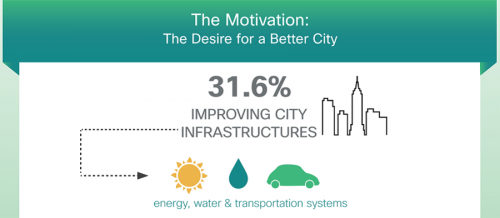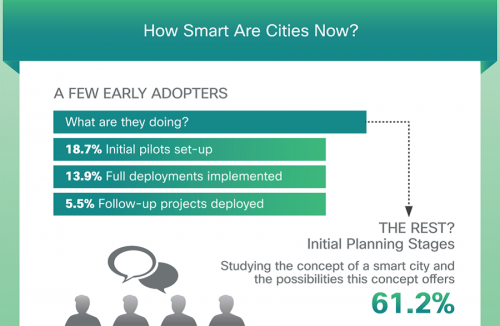
Top 5 guide to creating a Smart City
Imagine a city to be a living, breathing, evolving entity with a constantly shifting set of requirements…
Cisco believes that the development of smart cities can not only help to overcome many of the challenges associated with urbanisation like inadequate infrastructure, pollution, crime, congestion, to name but a few, but will also create a truly positive city living experience. Fundamental to the idea of a smart city is that all of its systems are integrated, making connectivity crucial. Research shows that the number of connected devices in cities increased 39% to 1.6 billion between 2015 and 2016: that figure is expected to jump to 3.3 billion in 2018. Our cities are rapidly becoming more joined up, and the technology in place impacts our lives in big, bold, interesting ways as you’ll see through this expedition, but there is still a way to go before our cities become truly smart.
It’s not just all about the technology. Cisco believes that a truly smart city is needs-driven, benefit-led and tech-enabled with the potential to create endless possibilities like new business and jobs; better healthcare, transport and education; safer streets; and more engaged and empowered citizens.
This all sounds perfect right, so why are we not experiencing more of these environments today?
Our survey findings for the readiness of cities to undertake smart city initiatives indicate;
- Some early adopters have smart city initiatives underway, but most are still in the planning stages.
- The biggest inhibitor for cities is funding, as officials are challenged to find the appropriate financial resources for both short and long-term projects.
- Internal organisational challenges, such as the lack of cross-departmental coordination and alignment. In addition, many cities need a committed champion to lead the effort across departments.
Consider these top 5 guidelines for enabling a smarter city:
1. Dare to dream…
In order to achieve results it’s important for cities to think big, but start small. In other words, think big initially with a holistic, citywide evaluation of the opportunity and the engagement of all the stakeholders—citizens, businesses, and city employees—right from the start. Equally important is the development of a smart-city roadmap with clear estimates of costs and benefits, along with a simple return-on-investment (ROI) analysis for individual projects.
2. What can you improve?

The most significant driver for smart city development is improving city infrastructures such as energy, water, and transportation systems. Nearly a third (31.6 percent) of the city officials identified that one of the top drivers in smart city development was improving their city infrastructures. So think, what are the critical services in your city that need transforming?
3. Plan to fail, fail to plan…
Some smart city projects have been initiated, mostly in smaller pilots, but overall, smart city development is still largely in various degrees of ‘planning’. And although planning is good, it is evident that cities need help in avoiding the downfall of endless city bureaucracy and getting pilot programs started. Many cities (31.9 percent) have engaged the citizens to find out their needs, and more than a quarter of the cities (27.8 percent) are in the process of determining funding requirements and sources. Others (21.6 percent) have created a smart city team or task force, while many (20.5 percent) are issuing Requests for Proposals (RFPs) to procure the appropriate technology and services.

4. Everyone on the same page?
Cities are challenged by lack of clarity around the benefits a smart city initiative would bring. They need better resources—tools, guidance, and expertise—to help them understand what a smart city initiative could do for their municipality.
5. Who’s paying for this…?
The top barrier to smart city development is funding, as cities are struggling to find innovative funding alternatives. Using historic models like government-based finance options, such as general obligation bonds, revenue bonds, are not always an option nowadays. Consider newer, less risk-oriented options that are now available like public-private partnerships, or different options for procuring technology, allowing cities to shift to a business model that defines these projects as operating expenditures versus capital expenses.
Based on the findings, there are clear steps that cities can take, such as getting assistance in leading projects, improving planning, and achieving a better understanding of the cost and benefits of a smart city. As they undertake the steps recommended here, they can move beyond the current barriers and start to capitalize on the benefits of a smart city.
Technology has often been accused of building barriers and increasing isolation but a smarter city can be the antithesis of that, bringing people back in touch with their environments, creating a happier connected community with more enriching environments and not just a population of connected individuals.
It is this combination of technology and business model innovations that will improve your city and create smart cities worldwide.
Visit Cisco and our ecosystem of IoT partners at Smart IoT London event to find out more about how we’re making cities smarter.
And check out CityVerve to see how we’re working with a consortium of partners to build a smart city demonstrator in Manchester.
Resources:
Tags:



